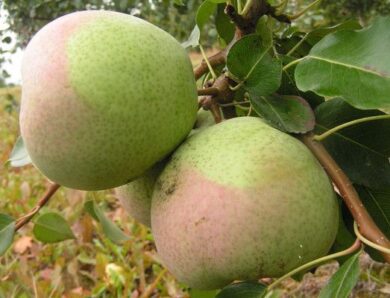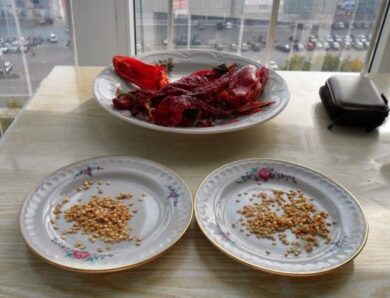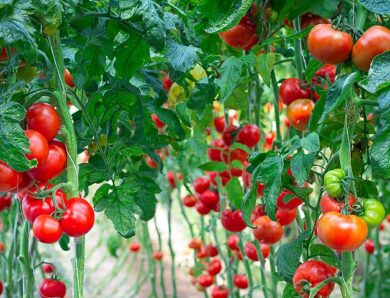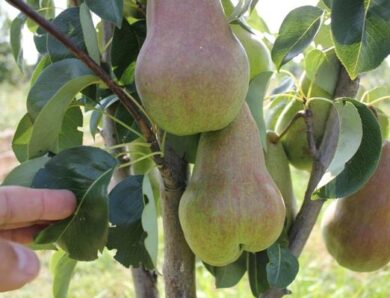Fuji apple tree: description and features of planting varieties
Fuji apple variety has long been a leader in private and industrial horticulture. This is one of the most successful developments of Japanese breeders, many decades that do not leave the top ten world varieties. Despite its exotic origins, Fuji variety is perfectly adapted to low temperatures, therefore it can be grown in the middle strip of Russia. And the highest varietal characteristics allowed to use it for further selection work as a result of which new hybrids were born - Fuji Kiku apple tree., Fujik, Fuji Aztec and others.
variety description
The late Fuji apple variety was bred at the beginning of the last century, therefore, the description of the variety should begin with history. So, Fuji is a hybrid of two very noble varieties: Red Delicious and Rolls Janet, which Japanese breeders have recognized as the most suitable for creating new fruits of extraordinary beauty and taste. The hybrid was obtained in 1920 in the Japanese province of Fujisaki, from which it got its name. The variety seemed so successful, which soon spread to the gardens of Western Europe, USA, and then around the world.
Fuji apple tree is medium or tall. If the tree is not restricted in growth, it reaches a height 6 m, but with competent forming pruning usually has a small (3-4 m) height and correct rounded crown. The trunk and main branches are light brown with a gray tinge, young shoots are lighter, bark slightly wrinkled. Leaves smooth lanceolate-oval, young leaves noticeably pubescent. Apple trees bloom late - in late May, therefore rarely suffer from spring frosts.
The fruits have an exceptional appearance. They are very large (200-250 G), correct round shape, slightly dilated at the peduncle. The surface of the skin is smooth, smooth, completely covered with a bright crimson blush. The flesh is creamy, juicy, very fragrant. But the special value of the variety lies in the excellent dessert taste, which as it matures changes from sweet and sour to honey, without the slightest sour taste.
Main characteristics
Apple, belonging to the Fuji variety - winter. Removable maturity of the fruit reaches the end of October, and consumer - in a month. A distinctive feature of the variety is high yields. The trees come into fruition early - through 2-3 years after planting. The first two harvests may not meet expectations in terms of fruit quantity and taste, but then the apple tree reaches its heyday, and pleases with very sweet apples of high quality. There is some periodicity in fruiting - every second year is more productive, than the previous one.
Trees have good resistance to frost and drought. This characteristic allows you to grow Fuji apples as in the south, and in temperate climates with long frosty winters. It is also worth noting good (average) scab resistance, but very low immunity to bacterial blight and powdery mildew.
Growing and care
Fuji apple trees are capable of self-pollination, however, planting in the neighborhood of such varieties, as Ligol, Golden, Faces Smith, Gala will help increase the yield and quality of fruit. Apple seedlings should be planted in a sunny area with good fertile soil - in this case, the apples will be brighter and sweeter. It is very important for the health of the tree to avoid waterlogging of the soil and air.
Basic care for apple trees includes the following measures:
- yield rationing (removal of excess ovary);
- loosening and mulching of stump circles;
- watering in hot weather;
- seasonal fertilization: in the spring - a nitrogen mixture (20 G / m?), in autumn - phosphorus 110 G, potassium 30 G, manure 4-6 kg (are introduced into the stem circles);
- crown formation.
Harvesting and storage
Fruit picking is carried out not earlier than mid-October, or even later. Because for the full ripening of apples you need to lie down for about a month, they can be left on the tree until the first frosts - after the fall of apple leaves, hung with bright large fruits, looks especially decorative. Fuji variety is intended for long-term storage. Even in normal storage conditions, the fruits are perfectly preserved 4-5 months, and when kept in the cold, their marketable and taste qualities are preserved until the next harvest, which allows you to grow apples for commercial purposes.
Diseases and pests
With proper care, which includes preventive treatments, almost always, manages to save and harvest. In the spring, apple trees should be sprayed during flowering 3% Bordeaux liquid - this measure will avoid scabies and fungal diseases (powdery mildew). To increase immunity, it is recommended to treat trees with a solution of urea (50 G / 10 And water) immediately after flowering.
Apple trees, grown in hot regions, aphids are often damaged. These insects do not harm fruits directly, because they feed on the juice of the leaves, however, their activity significantly weakens the tree, which affects yields. Nitrofen solution is effective for aphid control (300 G / 10 And water), as well as any universal insecticides. Spraying is carried out at the beginning of the growing season, and then before flowering.
Pros and cons
Of the shortcomings of the variety can be noted only the susceptibility of trees to infectious and fungal diseases, as well as irregular fruiting. But the advantages of the variety are much more:
- excellent resistance to drought and frost, which allows you to grow apples in temperate climates with all its features;
- excellent marketable appearance of apples, preservation and transportability;
- high taste and balanced fruit composition.
Thanks to these qualities, the Fuji variety is one of the best in the list of leaders for commercial cultivation, as evidenced by the numerous rave reviews from consumers and gardeners around the world.
Video "Review of winter varieties of apple trees"
In this video you will learn about the varieties of autumn-winter apple varieties.




